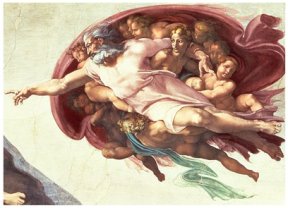
 URELY, YOU HAVE SEEN the painting of two arms outstretched toward one another, with the fingertips not quite touching each other. That scene is one of the centerpieces of the ceiling artwork in the Sistine Chapel. One of the two arms in the fresco is the right arm of God the Father, and the other is the arm of Adam, the first man. The artist rather dramatically depicts through those arms the passionate love of God, Who, ever since creating man, has constantly been reaching out to us.
URELY, YOU HAVE SEEN the painting of two arms outstretched toward one another, with the fingertips not quite touching each other. That scene is one of the centerpieces of the ceiling artwork in the Sistine Chapel. One of the two arms in the fresco is the right arm of God the Father, and the other is the arm of Adam, the first man. The artist rather dramatically depicts through those arms the passionate love of God, Who, ever since creating man, has constantly been reaching out to us.
Where is God’s other arm? We usually only see a cropped image of the two hands, but have you ever looked at the fuller panel to see what God the Father is doing with His left hand? What we see is this: God’s left arm is around the shoulder of a mother holding her child. That’s a remarkable detail! Michelangelo is teaching us that, even as God creates mankind and reaches out to us, He has already thought of, and in fact is embracing, the mother & child.
Motherhood is one of the great ideas God had for the world when He fashioned it, and every one of us has been the beneficiary. There is no way into this world without a mother—not even for the Son of God, Himself. The topic of motherhood makes me think of the long prayer Jesus prayed the night before He died, on the first Holy Thursday. I have a favorite line from that prayer. Jesus, speaking to His Father about us, says this: “Father, they are your gift to Me. I wish that where I am they also may be with me.” That is the way Jesus honestly thinks about us, His children, His sheep, His people. He considers us a gift!
Can’t you hear that line being spoken by your mother? Whether you’re an only child or one of 10, every mother worthy of the name would say the same thing about her children: “Father, they are your gift to me. I wish that where I am they also may be with me.” In so many ways, our society no longer sees children as a gift, and that is tragic. We need to reclaim the sense that children are pure gift—not an entitlement, not a burden, not something to be avoided, not to be taken advantage of or mistreated, and certainly not a choice. We also need to reclaim a healthy veneration for the role of mothers, since nothing could ever replace a good mother—no man, no machine, and no government program. Mothers are indispensable because of the love they bring into the world. Is there any warmer image—any image that better captures love & peace & joy—than the image of a mother holding her child?
The universal Church places just such an image before us. Today, the secular world celebrates Mother’s Day, which is a good & worthy celebration. But, in the Church, every year throughout the month of May, we honor the one great Mother whom we all mutually share. In so many statues and images of the Blessed Mother, we recognize the innate beauty of the Mother holding her Child. In my home parish growing up, our statue of Mary also showed her holding the brown scapular. For me personally, I wear the brown scapular as a daily reminder to me that Mary is, in fact, my Mother, and that I am a child in her arms. If you have never worn the scapular, I encourage you to be invested in it.
Some people think we Catholics focus too much on Mary. Many of our Protestant brothers & sisters think we are Mary worshippers. But those charges don’t make sense. For the same reason the world today recognizes natural mothers, the Church every May (and all year long) celebrates the gift of supernatural motherhood. In the words of St. Maximilian Kolbe: “ Do not be afraid to love the Immaculata too much, because we could never equal the love that Jesus has for her.”
